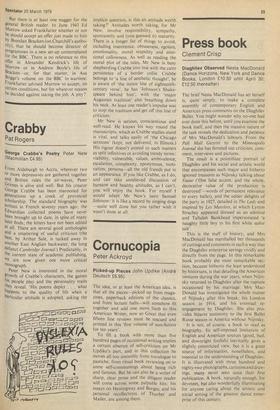Press book
Clement Crisp
Diaghilev Observed Nesta MacDonald (Dance Horizons, New York and Dance Books, London £10.50 until April 30; £12.50 thereafter) The brief Nesta MacDonald has set herself is, quite simply, to make a complete assembly of contemporary English and American press comments on the Diaghilev Ballet. You might wonder why no-one had ever done this before, until you examine the book itself, and then the massive nature of the task reveals the dedication and patience of Mrs MacDonald's labours. From the Pall Mall Gazette to the Minneapolis Journal she has ferreted out criticism, comment, interviews and pictures.
The result is a pointilliste portrait of Diaghilev and his social and artistic world that encompasses such major and hitherto ignored treasures as Nijinsky talking about Faune ('One false accent, and the whole, decorative value of the production is destroyed'—words of permanent relevance to every ballet), and the odder delights of the party in 1927, detailed in The Lady and inspired by Les Matelots, at which Lytton Strachey appeared dressed as an admiral and Tallulah Bankhead impersonated 'a naughty little boy in his first white sailor suit'.
This is the stuff of history, and Mrs MacDonald has marshalled her thousands of cuttings and comments in such a way that the Diaghilev enterprise springs vividly and directly from the page. In this remarkable book probably the most remarkable section, because hitherto the least understood by historians, is that detailing the American ventures during the war years, when Nijinsky returned to Diaghilev after the rupture occasioned by his marriage. Mrs MacDonald has investigated the whole matter of Nijinsky after this break: his London season in 1914, and his eventual reengagement by Diaghilev. She also provides bizarre testimony to the first Ballet Russe season in America without Nijinsky.
It is not, of course, a book to read as biography. Its self-imposed limitation of English and American sources (good, bad, and downright foolish) inevitably gives a slightly constricted view, but it is a great source of information, nonetheless, and essential to the understanding of Diaghilev. It is illustrated with three hundred and eighty-two photographs, cartoons and drawings, many never seen since their first publication. A book, naturally enough, for devotees, but also wonderfully illuminating for anyone caring about the artistic and social setting of the greatest dance enterprise of this century.


































 Previous page
Previous page